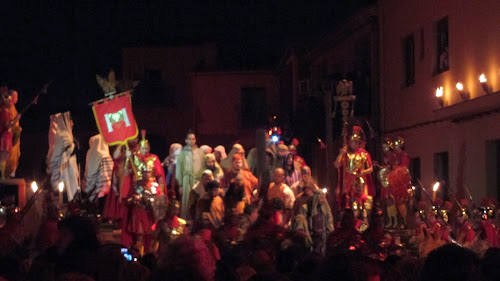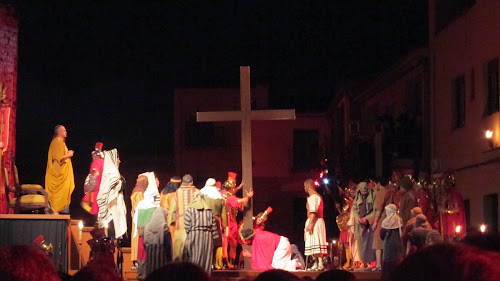One of the benefits of travel is that when confronted with quaint customs, or out and out bizarre traditions, one is forced to sit back and think about what makes these customs so bizarre. Which is not to say that Canada is not without its own bizarre traditions, and I don't mean just bathtub racing in Nanaimo. For instance I tell people here that in Canada we can't drink in public, that's right, no opened bottles of alcoholic beverages allowed in the streets, parks or beaches, and that causes wide-eyed stares of disbelief. I explain that it causes riots. Canadians riot because their sports teams lose, versus Europeans, who riot when the State takes away their rights. It's all a matter of priorities. Of course, there are English soccer hoodlums, but that's another tradition...
The passion play at Verges, in Catalonia is famous throughout Europe for one reason, it still contains the Medieval tradition of The Dance of Death, a particularly macabre and sinister element which has disappeared from all processions in Europe except here. Macabre? Spooky? Sinister? Weird? Medieval? Fits me to a "t", so naturally, I had to go. The event is in two parts, the Passion Play starting at 10pm in the town's main square. Now keep in mind that Verges is a tidy little medieval town of fewer than 1200 people, and between the play and the procession, I would say that more than 50% of the people are actually involved, the rest being no doubt involved in custom design, set design, the audio-visual components, which were amazing, using the latest laser projection technology, and the sound was accustically perfect. Numbered chairs are laid out in the main square, and around 9pm everyone is kicked out, and baracades are set up at all the entrances to the square. Hundreds of torches are attached to the walls of the route, and were it not for the flashes of cameras, it would all be frightfully authentic and medieval. A ticket is a very reasonable 15 euros, and the show begins at 10. It lasts two hours, which go by quickly, as there is a lot going on and it's all very professionally done, then the procession, which is free, starting directly from that stage, right after Pilot's sentence, with dozens and dozens of marching Romans in shiny golden armor.
Like most small towns in Catalunya, they are very much interested in leaving Spain, and civic buildings sport slogans and even the nationalist Catalan flag, which flies from the highest tower in the village
The idea of religious processions is something which is foreign to Canadians and Americans, with the Westborough Baptist Church and the Klu Klux Klan being pretty much the only ones who do any type of demonstrating these days. In Europe, however, and in South America, and everywhere else the Spanish colonized, (remembering that Spain still holds the record for largest empire ever), Catholic processions are standard issue. Likely the most famous in Spain is the one in Seville, with its dark, baroque and brooding solemnity, even the crowd is part of the act, all the women draped in their tall hair combs and black veils. Passion plays are not that uncommon in North America, usually amateurish affairs done by Church groups, and nothing like the massive professionally staged events common in Europe. The most famous passion play is in Oberammergau, Germany, though a few years ago Jewish groups asked them to tone down the Jewish component of the play since the Jews come out looking rather badly (well, they were after all responsible for killing Jesus; just sayin'). As a result, the following changes were instituted:
- changing some of the high priests' names from Old Testament names to newer New Testament-era names such as Demetrios, Alexander, or Bacchides;
- the role of the Temple traders has been reduced;
- the character "Rabbi" has been eliminated and his lines given to another character;
- Jesus has been addressed as Rabbi Yeshua;
- Jesus speaks fragments of Hebrew in the play;
- Jews have been shown disputing with others about Judaism, not just about Jesus;
- Pilate has been made to appear more tyrannical and some revision of lines was done to reflect that;
- Jesus' supporters have been added to the screaming crowd outside Pilate's palace;
- removing the line "His blood is upon us and also upon our children's children" (from Matthew 27:25), and "Ecce homo" (Behold the man);
- Peter, when questioned by Nathaniel regarding abandoning Judaism replies, "No! We don't want that! Far be it from us to abandon Moses and his law"; and
- at the Last Supper Jesus recites the blessing over the wine in Hebrew.
This is all quite absurd, naturally, and I feel for the Germans. This is a historic document, and changing it to reflect modern sensitivities rather misses the point. Last year the US changed several editions of Mark Twain's works because they contained the "N" word. In Canada many years ago, the edition of Shakespeare's Merchant of Venice was also changed to reflect Jewish sensitivities. Needless to say, I am against rewriting or sanitizing history, it's screwed up enough as it is, with what historians knowing to be true being quite a lot different from what the general public thinks happened. I could go on, but that will be the subject of another blog post.
In the Philippines, of course, they are famous for the brutality of their processions, with penitents whipping themselves to a bloody pulp in a religious frenzy and then having themselves actually crucified.
In comparison, the procession at Verges is a theatrical representation, with no actual whipping, just a lot of taunting of Jesus (they used ridicule, satire, and even, gasp, irony!). The church utilized theatre as an evangelizing tool, since masses were done in Latin, and 99.9999% of the population throughout Europe was illiterate and had no education; like Surrey, but without health care. Thus theatrical representations were the TV of the time, and the only opportunity to pass on the stories behind the Christian myths to an unsophisticated audience. The play at Verges is based on a version by fra Antoni de Sant Jeroni, dating from 1773, and is obviously in Catalan, but composed in short rhyming phrases, which makes it very easy to understand, and even remember, very much like Robert Service' "Cremation of Sam McGee." The act of procession has a long history in this tiny town, documented back to 1666, and likely further still.
I have been to quite a few processions and plays, though I am far from a connoisseur of this sort of thing. Every time I see a group of penitents marching down the street while flogging themselves I'm often inclined to yell, "no, no, no, you're doing it all wrong, gimme-that-gimme-that-gimme-that, you want pain? I'll give you pain. Here's how to properly use a whip..." Whenever I see a Roman whipping Jesus while carrying the cross, I'm inclined to yell, "is that the best you can do? Put some fore-arm muscle into it, dammit, harder, harder." I have promised myself I will not cause an international incident on this trip, and as I am currently the proud owner of Compostela Certificate No.2, freshly minted from Santiago with the Arch Bishop's personal rubber stamp on it, I'm feeling particularly Catholic (not really; I made it a point to find a steak house on Good Friday and ordered the largest steak they had, very well done, burnt to a crisp, with lots of Ali Oli; yes, I know, but I'm not a big meat eater. Nothing tastes quite as good as steak on Good Friday though. I intentionally chose a steak house because I figured they'd be slow. Wrong again. Hunger trumps Catholicism in Spain. For The Win!)
The scenes depicted below are Palm Sunday, the Samaritan Woman, The Last Supper, The Betrayal, the Garden of Gethsemane, and the Condemnation. I have interspersed some videos, as usual, please excuse the camera work, but it's all rather tricky without a tripod, but it will give some idea of the event.
The famous Dance of Death involves dancing skeletons dancing to the somber beat of a drum. One of them carries a sickle, a familiar element of the Grim Reaper, but another carries something that looks like a clock without hands. The symbolism is that time can run out anytime, and no one can predict death. In the Dark Ages, when plague, violence and death from child birth and infant mortality were very high, life was precious and seen as very fleeting, thus the Dance of Death is a medieval reminder of the precarious nature of our mortality.

The parade ends up at the front of the Church for the Crucifixion, complete with Romans throwing dice, laser clouds wiping past, a spear that spurts blood, and lots of other drama and gore, all wrapping up at 2:00am.
I actually saw people retire to taverns afterwards. They were obviously so moved they needed a pint or five to calm them down, which just proves my point: in Spain, Catholicism mostly consists of going through the motions.
People in Spain have the same internal clock as I do, sleep? meh, sleep when I'm dead, party on!


















No comments:
Post a Comment